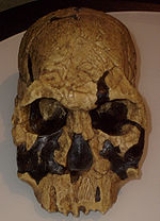
Homo rudolfensis
Encyclopedia
Homo rudolfensis is a fossil
human species
discovered by Bernard Ngeneo, a member of a team led by anthropologist Richard Leakey
and zoologist Meave Leakey
in 1972, at Koobi Fora
on the east side of Lake Rudolf (now Lake Turkana
) in Kenya
. The scientific name Pithecanthropus rudolfensis was proposed in 1978 by V. P. Alekseyev later changed to Homo rudolfensis by Bernard Wood
, for the specimen Skull 1470 (KNM ER 1470). Skull 1470 has an estimated age of 1.9 million years.
Originally thought to be a member of the species Homo habilis
, the fossil was the center of much debate concerning its species. Assigned initially to Homo habilis, the skull was at first incorrectly dated at nearly three million years old. The differences in this skull, when compared to others of the Homo habilis species, are too pronounced, leading to the presumption of a Homo rudolfensis species, contemporary with Homo habilis. It is not certain if H. rudolfensis was ancestral to the later species in Homo, or if H. habilis was, or if some third species yet to be discovered was.
In March 2007, a team led by Timothy Bromage, an anthropologist at New York University, reconstructed the skull of KNM-ER 1470. The new construction looked very ape-like (possibly due to an exaggerated rotation of the skull) and the cranial capacity based on the new construction was reported to be downsized from 752 cm³ to about 526 cm³, although this seemed to be a matter of some controversy. Bromage published his results in 2008 where the cranial capacity was now estimated at 700 cm³. Bromage said his team’s reconstruction included biological principles not known at the time of the skull’s discovery, which state that a mammal’s eyes, ears and mouth must be in precise relationships relative to one another.
Fossil
Fossils are the preserved remains or traces of animals , plants, and other organisms from the remote past...
human species
Homo
Homo may refer to:*the Greek prefix ὅμο-, meaning "the same"*the Latin for man, human being*Homo, the taxonomical genus including modern humans...
discovered by Bernard Ngeneo, a member of a team led by anthropologist Richard Leakey
Richard Leakey
Richard Erskine Frere Leakey is a politician, paleoanthropologist and conservationist. He is second of the three sons of the archaeologists Louis Leakey and Mary Leakey, and is the younger brother of Colin Leakey...
and zoologist Meave Leakey
Meave Leakey
Meave G. Leakey is together with her husband Richard Leakey one of the most renowned contemporary paleontologists. She studies the origin of mankind in Africa.-Flat-Faced Man of Kenya:...
in 1972, at Koobi Fora
Koobi Fora
Koobi Fora refers primarily to a region around Koobi Fora Ridge, located on the eastern shore of Lake Turkana in the territory of the nomadic Gabbra people. According to the National Museums of Kenya, the name comes from the Gabbra language:...
on the east side of Lake Rudolf (now Lake Turkana
Lake Turkana
Lake Turkana , formerly known as Lake Rudolf, is a lake in the Great Rift Valley in Kenya, with its far northern end crossing into Ethiopia. It is the world's largest permanent desert lake and the world's largest alkaline lake...
) in Kenya
Kenya
Kenya , officially known as the Republic of Kenya, is a country in East Africa that lies on the equator, with the Indian Ocean to its south-east...
. The scientific name Pithecanthropus rudolfensis was proposed in 1978 by V. P. Alekseyev later changed to Homo rudolfensis by Bernard Wood
Bernard Wood
Bernard John Wood FRS is a British geophysicist, and Research Professor, at Oxford University. He is a Fellow of the American Geophysical Union.-Life:...
, for the specimen Skull 1470 (KNM ER 1470). Skull 1470 has an estimated age of 1.9 million years.
Originally thought to be a member of the species Homo habilis
Homo habilis
Homo habilis is a species of the genus Homo, which lived from approximately at the beginning of the Pleistocene period. The discovery and description of this species is credited to both Mary and Louis Leakey, who found fossils in Tanzania, East Africa, between 1962 and 1964. Homo habilis Homo...
, the fossil was the center of much debate concerning its species. Assigned initially to Homo habilis, the skull was at first incorrectly dated at nearly three million years old. The differences in this skull, when compared to others of the Homo habilis species, are too pronounced, leading to the presumption of a Homo rudolfensis species, contemporary with Homo habilis. It is not certain if H. rudolfensis was ancestral to the later species in Homo, or if H. habilis was, or if some third species yet to be discovered was.
In March 2007, a team led by Timothy Bromage, an anthropologist at New York University, reconstructed the skull of KNM-ER 1470. The new construction looked very ape-like (possibly due to an exaggerated rotation of the skull) and the cranial capacity based on the new construction was reported to be downsized from 752 cm³ to about 526 cm³, although this seemed to be a matter of some controversy. Bromage published his results in 2008 where the cranial capacity was now estimated at 700 cm³. Bromage said his team’s reconstruction included biological principles not known at the time of the skull’s discovery, which state that a mammal’s eyes, ears and mouth must be in precise relationships relative to one another.
See also
- Cranial capacityCranial capacityCranial capacity is a measure of the volume of the interior of the cranium of those vertebrates who have both a cranium and a brain. The most commonly used unit of measure is the cubic centimetre or cc...
- List of fossil sites (with link directory)
- List of hominina (hominid) fossils (with images)
External links
- Archaeology Info
- Science Daily article
- Talk Origins - Skull KNM-ER 1470
- Homo rudolfensis - The Smithsonian Institution's Human Origins Program

